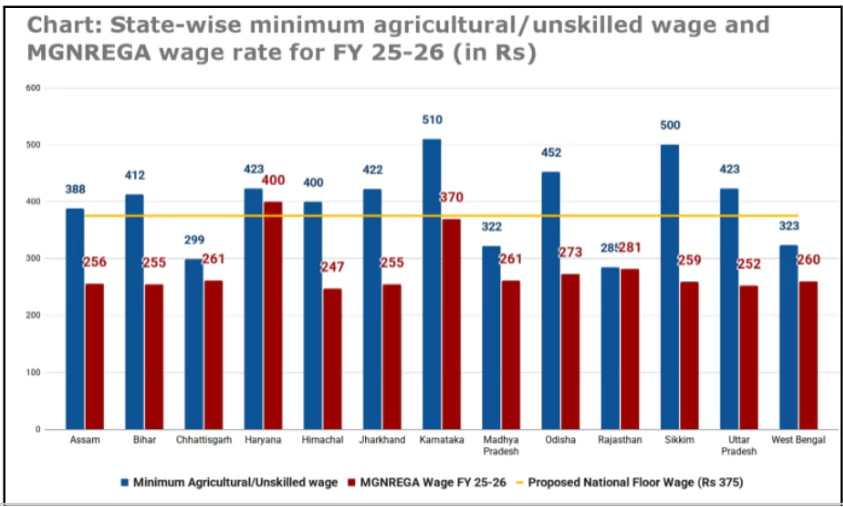Recently the Parliamentary Standing Committee on Rural Development and Panchayati Raj tabled a report raising serious concerns about the Mahatma Gandhi National Rural Employment Guarantee Act (MGNREGA) wage rates.
Key Highlight of the report
- Inadequate Wage rate : MGNREGA wages have failed to keep pace with inflation and remain below subsistence levels, undermining the scheme’s goal of providing economic security to rural households.
About MGNREGA
- The Mahatma Gandhi National Rural Employment Guarantee Act (MGNREGA) is the world’s largest employment guarantee programme, aiming to enhance livelihood security by providing at least 100 days of wage employment each year to rural households whose adult members volunteer to do unskilled manual work.
- Launch: MGNREGA was enacted in 2005 and came into force on February 2, 2006.
- It is a rights-based framework that legally guarantees rural employment, making the government accountable for providing jobs on demand.
- Implementation: The scheme is implemented by the Ministry of Rural Development (MoRD) in partnership with state governments.
- Gram Panchayats play a crucial role in planning and executing projects under MGNREGA, ensuring that local needs guide the nature of work undertaken.
- Funding Structure
-
- MGNREGA is primarily funded by the Central Government, which bears 100% of the cost of unskilled labour and 75% of the material cost.
- State governments contribute the remaining 25% of the material cost and are responsible for unemployment allowances when work is not provided within 15 days of demand.
Achievements under Mahatma Gandhi NREGA
- Massive Employment Generation: Since its launch in 2006, MGNREGA has generated over 31 billion person-days of employment.
- For FY 2024-25, it generated 196.30 Cr Person-days of rural work.
- Currently it has 25 crore registered workers.
- Large-Scale Financial Investment: The government has spent over ₹6.4 lakh crore on this demand-driven employment scheme over the years.
- The allocation for MGNREGA was ₹86,000 crore in the Union Budget 2025.
- Water Conservation Efforts: More than 30 million water conservation-related assets (like ponds, canals, check dams) have been created.
- Technology-Driven Implementation: Introduction of tools like online registration, electronic fund transfer, and geotagging of assets through mobile apps to boost transparency and efficiency.
- Impact on Rural Wages: Various studies highlight that MGNREGA contributed to raising rural wages indirectly by enhancing workers’ bargaining power.
- It became a lifeline during crises, especially during the Covid-19 pandemic.
|
How MGNREGA Wage Rates are Determined?
- Section 6 of the MGNREGA Act outlines two methods:
- Section 6(1): The Centre can notify the wage rate, which must not be lower than Rs 60, irrespective of the Minimum Wages Act, 1948 (MWA).
- Section 6(2): Until the Centre notifies a wage rate, the state’s minimum agricultural wage is to be adopted.
- Initially, from 2005 to 2009, MGNREGA wages matched the states’ minimum agricultural wages.
- However, rising costs led the Centre to cap MGNREGA wages at Rs 100 in 2009, causing divergence from the minimum wages and violating the MWA.
- Since 2011-12, MGNREGA wages have been indexed to the Consumer Price Index for Agricultural Labourers (CPI-AL), but the base year remains outdated (2009).
Issues Regarding MGNREGA Wage Rates

- Divergence from Minimum Wage: MGNREGA wages have increasingly fallen below the states’ minimum agricultural wages.
- For example, In FY 2025-26, the gap is as high as Rs 241 in Sikkim.
- Disparities Across States: Wage rates vary significantly across states.
- For example, in FY 2025-26, wages range from Rs 241 in Nagaland to Rs 400 in Haryana with a gap of Rs 159.
- Poor Inflation Indexation: The use of CPI-AL (instead of the broader CPI-Rural) and maintaining 2009 as the base year have led to inadequate adjustments for inflation, resulting in wages that fail to reflect current cost-of-living realities.
- Ignored Committee Recommendations: Despite setting up multiple expert committees , the Centre has largely ignored their
- key recommendations on wage revision and inflation adjustments.
| Committee |
Recommendations |
| Mahendra Dev Committee (2014) |
- MGNREGA wage ≥ state minimum wage
- Index wage to CPI-R (base year 2014)
|
| Nagesh Singh Committee (2017) |
- No need to link MGNREGA wage to state minimum wage
- Shift index from CPI-AL to CPI-R
|
| Anoop Satpathy Committee (2019) |
- Set National Floor Wage at Rs 375/day (July 2018 prices) for all sectors, including NREGA
|
- Worker Attrition and Scheme Effectiveness: Low wages have been cited as a major reason for worker dropout from MGNREGA, undermining the scheme’s impact on rural livelihoods.
- Constitutional Concerns: Paying less than the minimum wage can be considered “forced labour,” violating Article 23 of the Constitution, as noted in the Supreme Court’s Sanjit Roy vs State of Rajasthan (1983) judgment.
Way Forward
- Link MGNREGA Wages to State Minimum Wages: Wages under MGNREGA must not fall below the minimum agricultural wage of the respective state to ensure fairness and legality.
- Adopt CPI-Rural for Indexation: Switch the wage indexation from CPI-AL to CPI-Rural, which better represents the consumption patterns of all rural workers, not just agricultural households.
- Update the Base Year for Inflation Indexing: Revise the outdated 2009 base year to a more recent year (e.g., 2018-19) to reflect current market realities and living costs.
- Introduce a National Floor Wage: Implement a National Floor Wage, as suggested by the Anoop Satpathy Committee, ensuring no worker is paid below a basic minimum threshold across the country.
- Allow States to Supplement Central Wages: Encourage and facilitate states to top up MGNREGA wages from their own resources if needed, ensuring workers receive wages closer to local minimum wages.
- Ensure Regular and Transparent Wage Revisions: Institutionalize an annual, transparent mechanism for wage revision, taking into account inflation, minimum wage updates, and economic conditions.
Conclusion
MGNREGA was envisioned to guarantee dignified employment and secure rural livelihoods. Unless the issue of unfair and inadequate wages is addressed, this vision will remain unfulfilled. Ensuring fair, inflation-adjusted, and constitutionally compliant wages is critical for restoring the dignity and economic security of MGNREGA workers.
![]() 11 Apr 2025
11 Apr 2025


